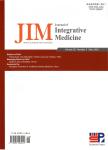Effects of self-administered exercises based on Tuina techniques on musculoskeletal disorders of professional orchestra musicians: a randomized controlled trial
Effects of self-administered exercises based on Tuina techniques on musculoskeletal disorders of professional orchestra musicians: a randomized controlled trial作者机构:Institute of Biomedical Sciences Abel Salazar University of Porto Porto Polytechnic Institute Superior School of Music and Performing Arts German Society of Traditional Chinese Medicine Heidelberg School of Chinese Medicine
出 版 物:《Journal of Integrative Medicine》 (结合医学学报(英文版))
年 卷 期:2015年第13卷第5期
页 面:314-318页
核心收录:
学科分类:1005[医学-中医学] 1002[医学-临床医学] 100512[医学-针灸推拿学] 10[医学]
主 题:Tuina musculoskeletal disorders professional orchestra musicians randomized controlled trial
摘 要:BACKGROUND: Musicians are frequently affected by playing-related musculoskeletal disorders (PRMD). Common solutions used by Western medicine to treat musculoskeletal pain include rehabilitation programs and drugs, but their results are sometimes disappointing. OBJECTIVE: To study the effects of self-administered exercises based on Tuina techniques on the pain intensity caused by PRMD of professional orchestra musicians, using numeric visual scale (NVS). DESIGN, SETTING, PARTICIPANTS AND INTERVENTIONS: We performed a prospective, controlled single-blinded, randomized study with musicians suffering from PRMD. Participating musicians were randomly distributed into the experimental (n = 39) and the control (n = 30) groups. After an individual diagnostic assessment, specific Tuina self-administered exercises were developed and taught to the participants. Musicians were instructed to repeat the exercises every day for 3 weeks. MAIN OUTCOME MEASURES: Pain intensity was measured by NVS before the intervention and after 1, 3, 5, 10, 15 and 20 d of treatment. The procedure was the same for the control group, however the Tuina exercises were executed in points away from the commonly-used acupuncture points. RESULTS: In the treatment group, but not the control group, pain intensity was significantly reduced on days 1, 3, 5, 10, 15 and 20. CONCLUSION: The results obtained are consistent with the hypothesis that self-administered exercises based on Tuina techniques could help professional musicians controlling the pain caused by PRMD. Although our results are very promising, further studies are needed employing a larger sample size and double blinding designs.



